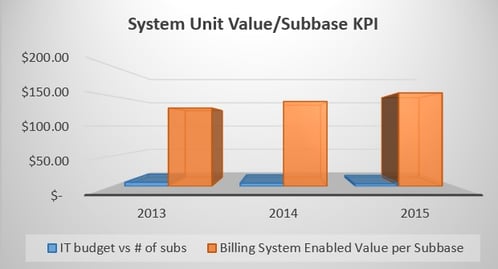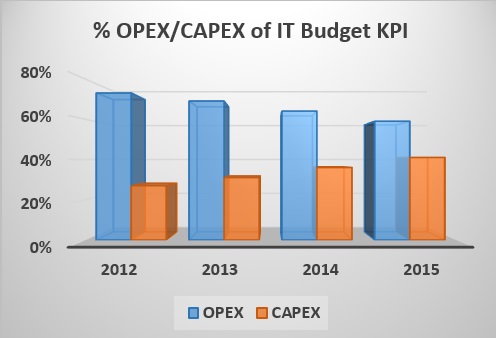Albert Einstein is famously quoted as saying, “Everything that can be counted does not necessarily count; and everything that counts cannot necessarily be counted.” Determining what counts and what can be counted in terms of IT metrics, or what are commonly called Key Performance Indicators (KPIs), is challenging, especially when attempting to measure the value that IT delivers to the business.
I enjoyed Mark Settle’s recent and somewhat tongue-in-cheek guest post on this site, The 4 Most Meaningless IT Metrics, which got me thinking about the KPIs I have found to be the most beneficial and meaningful during my IT career.
There is plenty of information published on IT KPIs, but in my opinion there are two publications that stand out. One is the book The Real Business of IT, by Hunter and Westerman, which focuses on measuring the value that IT brings to the business. The second is Forrester’s publication on the Business Technology Scorecard which proposes a framework for creating, measuring, and acting on IT KPIs that help align IT with the business and provide a measurable IT value.
Drawing from both publications and applying my own experience, I propose the following seven KPIs that can help CIOs demonstrate IT value and ultimately improve the communication between the CIO and the executive team:
1. IT budget percentage of revenue
This is an industry standard KPI that should be measured year-over-year (YoY), analyzed, and compared to other organizations in the same or even different sectors. This KPI shows whether IT is run like a business, an aspiration of every savvy CIO. In addition:- This KPI can indicate the effectiveness of utilizing IT resources regardless of whether these resources are used for cloud deployed or on premise solutions. If this KPI is below or above industry norms by 20%, 30%, or more, then IT is not providing the right value. IT is either inefficient or underinvesting. It is possible to have a large deviation from industry norms on this KPI, but that should be discussed and aligned with the executive team as part of a larger plan or a transformational investment. In other words, high deviation is the exception not the rule.
- Tremendous insight can be gained when looking at this KPI in YoY comparisons and over many years. The CIO can set a target for this KPI as part of the IT strategic plan. This means that IT works with the business team to manage IT investments to bring the best value to the organization.
- This KPI is very useful to CIOs in a new job who need to conduct a comprehensive assessment of their new IT department. Measuring this KPI will help guide which areas of the IT department the assessment should focus on.
2. Unit cost per customer
This KPI is calculated as the annual IT spend divided by the number of end customers the business serves. This KPI is valuable in YoY trends where setting target values is coordinated with the executive business team and is synchronized with proper capacity planning to achieve an optimal value. This is an essential KPI in subscription based businesses such as telecom, online subscriptions, or even ecommerce. This KPI can also be useful for nonprofit and governmental organizations.
3. Pure unit value
IT value is best measured through the benefits or revenue achieved vs. the unit cost of systems, products, or services delivered. It is important to create a value KPI by accounting for all the revenue enabled by IT systems and then dividing that by the number of customers to reach the “unit revenue KPI”. This can then be deducted from the unit cost of the system to achieve the “pure unit value KPI”. For example, if an IT department operates a system that directly brings in revenue (e.g., charging, billing, subscription, ticketing, or ecommerce system), then the revenue that is enabled by this system can be divided by the number of active customers and then deducted from the unit- cost/customer. A sample of such KPI over a number of years is shown in the image below. This will show the cost of IT vs. the value that IT brings in to the business.

4. Percentage of IT budget spent on OPEX and CAPEX
Dividing the IT OPEX budget (spent running the business) or IT CAPEX budget (spent growing and transforming the business) by the total IT budget produces two numbers that show two sides of the same coin. For most organizations, OPEX hovers around 70% of the total IT budget, but high performing IT departments can reduce OPEX down to 50% which frees up resources to new investments to help grow the business. YoY trends of this KPI are useful for the proper understanding of the current status of IT assets and investments and where they should be in the following year or years. Drilling into the OPEX component of this KPI by system can show which systems are becoming too costly to operate and potentially requiring replacement or an upgrade. Below is a sample plan to reduce the OPEX budget over time.

5. Unit cost per user
This KPI is a widely accepted and utilized measurement for back-office or non-revenue generating systems such as email or ERP. It is simply the total cost to run a system or systems divided by the number of users. It is the best metric to assess efficiency and improve IT's value by comparing your user unit costs with that of other companies.
6. Agility
This KPI measures the speed at which IT delivers products and services to the business. It answers the question: “What is the time to market from the IT perspective,” i.e., how long does it take IT to deliver certain products or services, such as online marketing campaigns that are enabled through IT, and simple services such as the helpdesk.
To calculate agility, I subtract the actual duration (in days, weeks or months) from the planned duration, and divide that number by the planned duration to produce a percentage number. That generates agility KPI that can be compared YoY. For example, if you had 25 projects of various sizes in a year with a total planned duration of 1,200 days, but they were delivered in 1,400 days, the agility would be measured as follows: (1,400-1,200)/ 1,200= 16.6%.
7. Project Delivery
This KPI is calculated by averaging the total planned vs. actual time and budget consumed by each project to produce numbers that show the effectiveness and efficiency of the IT department in delivering such projects.
This KPIs list is by no means comprehensive. They are very useful for many CIOs and defying Einstein’s paradox, they count and should be counted to show the value that IT brings to the business.


Written by Saeed Elnaj
Saeed Elnaj is the CIO for RELI Group. Earlier, he was Chief Information and Technology Officer (CITO) at HealthKey Technologies, and Vice President of IT and CIO at the National Council on Aging. He has over 25 years of IT experience with industry leading organizations that also include Oracle, Ericsson, and Project Concern International.



